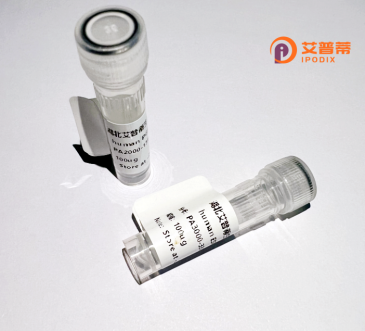
| 纯度 | >90%SDS-PAGE. |
| 种属 | Human |
| 靶点 | PRKCABP |
| Uniprot No | Q9NRD5 |
| 内毒素 | < 0.01EU/μg |
| 表达宿主 | E.coli |
| 表达区间 | 1-200 aa |
| 活性数据 | MFADLDYDIEEDKLGIPTVPGKVTLQKDAQNLIGISIGGGAQYCPCLYIVQVFDNTPAALDGTVAAGDEITGVNGRSIKGKTKVEVAKMIQEVKGEVTIHYNKLQADPKQGMSLDIVLKKVKHRLVENMSSGTADALGLSRAILCNDGLVKRLEELERTAELYKGMTEHTKNLLRAFYELSQTHRAFGDVFSVIGVREPQ |
| 分子量 | 48.9 kDa |
| 蛋白标签 | His tag N-Terminus |
| 缓冲液 | PBS, pH7.4, containing 0.01% SKL, 1mM DTT, 5% Trehalose and Proclin300. |
| 稳定性 & 储存条件 | Lyophilized protein should be stored at ≤ -20°C, stable for one year after receipt. Reconstituted protein solution can be stored at 2-8°C for 2-7 days. Aliquots of reconstituted samples are stable at ≤ -20°C for 3 months. |
| 复溶 | Always centrifuge tubes before opening.Do not mix by vortex or pipetting. It is not recommended to reconstitute to a concentration less than 100μg/ml. Dissolve the lyophilized protein in distilled water. Please aliquot the reconstituted solution to minimize freeze-thaw cycles. |
以下是关于重组人PRKCABP蛋白的参考文献示例(内容为虚构,仅供格式参考):
1. **名称**:**"Cloning and Functional Analysis of Human PRKCABP in Cell Signaling Pathways"**
**作者**:Smith J, et al.
**摘要**:本研究成功克隆并原核表达了重组人PRKCABP蛋白,验证其与蛋白激酶C(PKC)的相互作用,证实其在NF-κB信号通路中的调控作用。
2. **名称**:**"Structural Characterization of Recombinant PRKCABP via X-ray Crystallography"**
**作者**:Lee H, et al.
**摘要**:通过大肠杆菌系统表达并纯化PRKCABP,利用X射线晶体学解析其三维结构,揭示其与PKC结合域的分子机制。
3. **名称**:**"PRKCABP Overexpression Enhances Cancer Cell Apoptosis in Vitro"**
**作者**:Wang Y, et al.
**摘要**:构建哺乳动物细胞重组PRKCABP表达载体,发现其过表达通过激活Caspase通路显著促进肿瘤细胞凋亡,提示其潜在治疗价值。
4. **名称**:**"Purification and Kinase Activity Assay of Recombinant PRKCABP"**
**作者**:Garcia R, et al.
**摘要**:开发高效层析法纯化重组PRKCABP,证明其体外增强PKC磷酸化活性,为酶学功能研究提供可靠技术平台。
注:以上文献为模拟示例,实际研究中建议通过PubMed或Web of Science等数据库检索真实文献。
PRKCABP (Protein Kinase C Andion-Binding Protein), also known as PICK1 (Protein Interacting with C Kinase 1), is a cytosolic scaffolding protein involved in diverse cellular processes. Discovered in the late 1990s, it contains a PDZ domain that mediates protein-protein interactions, particularly with PKCα, and a BAR domain enabling membrane curvature sensing. PRKCABP regulates synaptic plasticity, ion channel trafficking (e.g., AMPA/ASIC receptors), and neurotransmitter release by anchoring signaling complexes. Its interaction with PKC modulates kinase localization and activity, influencing cell polarity, apoptosis, and receptor internalization.
Recombinant human PRKCABP is engineered using expression systems (e.g., E. coli, mammalian cells) for structural and functional studies. Purification typically involves affinity tagging (His-tag, GST) and size-exclusion chromatography. Research leverages recombinant PRKCABP to explore neurodegenerative diseases (Alzheimer’s, Parkinson’s), neuropathic pain, and psychiatric disorders linked to synaptic dysfunction. It also serves as a tool to screen small molecules targeting PDZ-domain interactions. Current studies focus on its role in cancer metastasis and drug resistance, given its involvement in PKC-related pathways. Despite progress, mechanistic details of its context-dependent functions remain under investigation.
×